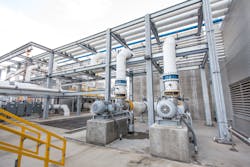About the author:
Cristina Tuser is associate editor for WWD. Tuser can be reached at [email protected].
Name: Claude “Bud” Lewis Carlsbad Desalination Plant
Location: Carlsbad, California
Size: 50 mgd
Population served: 400,000
Equipment: Energy recovery devices, pressure vessels, reverse osmosis membranes
Located in Carlsbad, California, Claude “Bud” Lewis Carlsbad Desalination Plant is the largest seawater desalination plant in the nation. The plant delivers nearly 50 million gallons of fresh, desalinated water to San Diego County on a daily basis.
A 30-year water purchase agreement is in place between the San Diego County Water Authority and Poseidon Water, a water project development specialist, for the entire output of the plant. The plant has delivered water to San Diego County since December 2015 and normally operates with a staff of approximately 40 employees working full time. This has since changed after public health orders announced that no more than 10 people can congregate in one place.
The seawater desalination plant currently has a 10-mile water delivery pipeline, providing the only water supply in San Diego County that is not dependent on snowpack and rainfall. Originally developed in mid-1998 by local officials, including Claude “Bud” Lewis, the mayor of Carlsbad at the time, the plant only started construction in 2012. This construction concluded in late 2016. In its 4.5 years of operation, the plant has provided San Diego County with more than 62 billion gallons of drinking water.
Since the implementation of various COVID-19 (coronavirus) social distancing measures, many businesses have shut down operations. Nevertheless, the water industry is adapting to this change, and the Carlsbad Desalination Plant is no exception. As the plant plays a crucial role in lives of San Diego County, it has been working with its Plant Operator, IDE Americas Inc., to assemble a team of mission-critical employees to shelter in place.
The team members, each of whom have voluntarily agreed to shelter in place, were charged with ensuring continued water supply production and overseeing this critical regional facility. The volunteer team members started living on site March 19, 2020, and anticipated to isolate themselves at the facility for the next 21 days to maintain plant operations and avoid exposure. The volunteers worked in two different shifts to handle operations and maintenance needs.
While this on-site team sheltered in place, a second team remained in isolation at home. This team was tasked with staying prepared to take over plant operations in the event a change in staffing was necessary.
The first team was relieved by a second crew April 9, and the new crew of 10 employees remained at the plant until April 30.
Precautions to shelter in place at the plant include the use of RVs for lodging and no-contact food and supply deliveries. Creating a comforting and supportive environment has been a top priority, according to the IDE Americas Inc.
“Each and every one of us here at the Carlsbad Desalination Plant could not have been prouder to provide safe and clean water to our community,” said the original group of IDE Americas Inc. volunteers in a statement.
